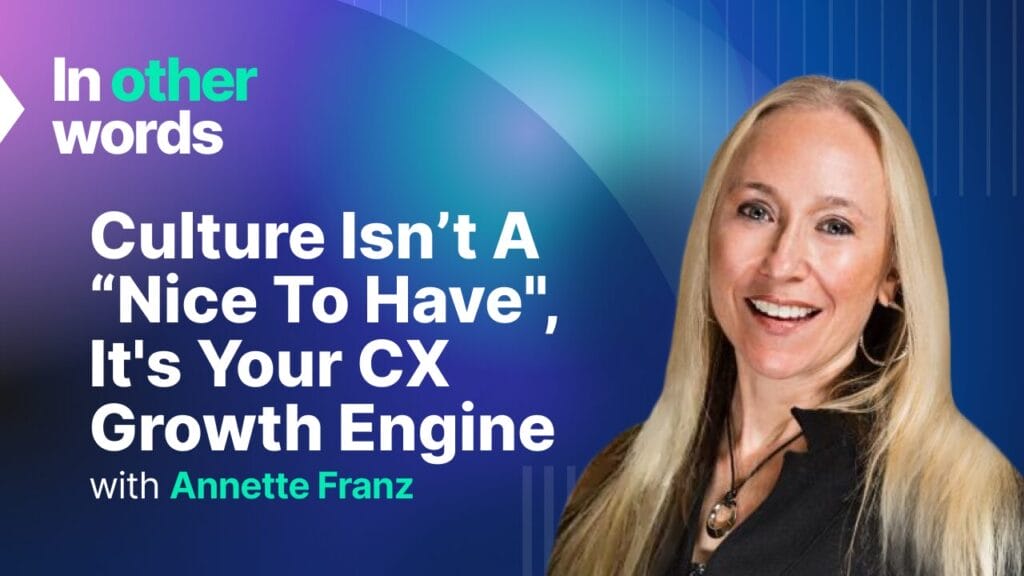Executive Summary
AI is moving from experimentation to the “big kids’ playground” — mission-critical systems in finance, commerce, and regulated industries. In this environment, hype is irrelevant. What matters for C-suite leaders is whether AI can be scaled with trust, resilience, and compliance.
That was the central message from Meeta Yadav Vouk, VP of AI and Analytics at Teradata, and Simone Bohnenberger-Rich, PhD., CPO at Phrase, in a recent conversation with host Jason Hemingway for the latest episode of In other words, a podcast from Phrase where we explore global growth with a variety of enterprise leaders and experts. Both leaders stressed that AI in the enterprise is less about dazzling prototypes and more about building guardrails, governance, and global adaptability.
Key takeaways include:
- Trust is non-negotiable. Explainability, transparency, and auditability must be built into every system. Without them, enterprises risk reputational damage, regulatory penalties, and customer backlash.
- Global complexity demands local nuance. Fraud in Sweden looks different from fraud in England; tone of voice in Japan is not the same as in the U.S. Sovereign AI regulations will make one-size-fits-all models impossible.
- Human oversight must be rethought. Traditional “check everything at the end” approaches don’t scale. Instead, humans should step in only at points of high risk or low confidence.
- Not everything should be automated. Creativity and storytelling remain uniquely human differentiators. AI should amplify, not replace, them.
- The next five years are formative. Deep reasoning models, agentic AI, and governance frameworks will mature. The true test of success: when AI becomes so embedded in business that we stop talking about it.
For executives, the mandate is clear: build AI strategies anchored in trust, resilience, and human value — or risk being left behind as the formative years of enterprise AI unfold.
AI may dominate headlines, but in the boardroom, the question isn’t whether to use it. It’s how to deploy it at scale safely, profitably, and globally.
For Dr. Meeta Yadav Vouk, VP of AI and Analytics at Teradata, the answer is clear: AI belongs in the “big kids’ playground.” That means enterprise-grade resilience, regulatory compliance, and trust baked in from the ground up. In conversation with Phrase CPO Simone Bohnenberger-Rich, PhD., and Jason Hemingway, host of the In other words podcast.
Meeta outlined the realities of bringing AI from prototype to production across mission-critical workloads, and why guardrails, governance, and humility matter more than hype.
“We don’t believe in AI for AI’s sake,” Meeta says. “Our job is to make AI work in the most demanding environments: financial systems, global commerce, regulated industries. That means scalability, auditability, and trust. If it isn’t enterprise-grade, it doesn’t belong.”
From research labs to mission-critical systems
Meeta’s journey into AI began in academia, where her PhD — funded by the U.S. Department of Defense — explored how cyberattacks could be modeled in hardware at scale. From there she moved to IBM Research Singapore, applying AI in one of the world’s busiest ports to detect illegal fuel bunkering. It was an early, tangible example of how machine learning could spot patterns and act in complex, real-time environments.
Those lessons carry through to her work today at Teradata, where the stakes are far higher. “Every time you swipe your card, buy a ticket, or move goods across borders, you’re interacting with workloads that have zero tolerance for failure,” she says. “That’s the reality of enterprise AI.”
The enterprise paradox: when predictability meets probability
Enterprises are built on predictability. Strategies, forecasts, and risk models designed to minimize surprises. But as Simone pointed out, AI doesn’t play by those rules. By nature it’s probabilistic, not deterministic.
“It’s like trying to fit a square peg into a round hole,” she said. “Executives want scalability, transparency, and explainability. But the mathematics of AI resists neat, deterministic answers.”
“We don’t believe in AI for AI’s sake. Our job is to make AI work in the most demanding environments — financial systems, global commerce, regulated industries. That means scalability, auditability, and trust. If it isn’t enterprise-grade, it doesn’t belong.”
– Dr. Meeta Vouk
That tension helps explain why so much investment stalls short of impact. Billions have been poured into AI, yet only a fraction of projects ever make it out of proof of concept. Goldman Sachs has called it a “trillion-dollar wave,” but for many enterprises, the reality is sobering: fewer than two in ten pilots become production systems. For the C-suite, the gap between ambition and execution is widening.
Global complexity, local nuance
Regulation is quickly becoming one of the toughest barriers to scaling AI. “We thought data was hard,” Meeta reflected. “Now add AI regulations on top. Europe looks different from the U.S., which looks different again from Asia. Fraud in Sweden doesn’t look like fraud in England. You can’t just build one model and scale it everywhere.”
This is the rise of so-called “sovereign AI,” where governments require data and models to operate within local jurisdictions. For enterprises, the challenge is balancing global consistency with local compliance, often tailoring fraud detection, KYC processes, and risk models country by country.
Simone emphasized that it’s not only technical. “Compliance is one thing. But nuance matters. Tone of voice, personalization, cultural sensitivity. Get it wrong in Japan, and you erode trust instantly. AI pipelines have to be designed with flexibility all the way through.”
Guardrails, trust, and the human in the loop
If there was one theme both speakers came back to, it was trust. But what does “trusted AI” actually mean?
For Meeta, it starts with explainability.
“AI is arrogant. It gives you answers with confidence. I want it to say: ‘I am AI. Here’s why I made this decision. Here’s my confidence level. And here are the factors I considered.’ That transparency is what builds trust.”
– Dr. Meeta Vouk
She pointed to the EU AI Act as a step in the right direction, pushing the industry toward clear guardrails. Without them, risks multiply: hallucinations, rogue agents, and reputational fallout. To make it tangible, she told a story about her son being unexpectedly scolded by a telecom AI agent: “I don’t want to be told off by AI. I want it to make my life simpler, not noisier.”
Simone argued that trust also depends on rethinking where humans sit in the process. Traditional “check everything at the end” governance doesn’t scale. Instead, she said, organizations should escalate to people at moments of high risk or low confidence, while automating routine cases. One example is Tractable, a UK insurance startup that routes simple claims through AI automatically but passes complex ones to humans mid-process.
“Enterprises love predictability, scalability, and trust — but that’s almost anathema to the mathematics underpinning AI, because it’s probabilistic. That’s the tension every global organization has to manage.”
– Simone Bohnenberger-Rich PhD
What should remain human?
Despite her technical background, Meeta was clear: not everything should be automated. “A novel written by AI doesn’t resonate the way a novel written by a human does,” she said. “Art, storytelling, creativity… these are deeply human. AI can support, but it can’t replace that humanity.”
Simone took a more nuanced view. She compared AI to new artistic mediums, like Duchamp’s urinal or Warhol’s screen prints — tools that expand creativity rather than erase it. In business, she argued, AI’s value lies less in originality than in relevance. “People don’t want clutter. They want relevance. AI can help us deliver that, but only with the right context.”
The next three to five years
Both guests agreed the next few years will be formative. Deep reasoning models, agentic platforms, and governance frameworks are all maturing, enabling AI to handle fraud detection, compliance, and customer interactions with greater confidence.
For Meeta, the milestone is cultural as much as technical:
“AI will be successful when we stop talking about AI. That’s when it becomes part of the fabric of business.”
– Dr. Meeta Vouk
Simone framed it as risk management. “The goal isn’t zero risk. That’s impossible. The goal is calibrated risk, managed with transparency and agility.”
Closing reflection
Across the conversation, one message cut through: trust is the foundation. Without it, compliance falters, customers push back, and employees resist. With it, enterprises can scale AI across systems, cultures, and markets.
As Jason Hemingway put it in closing: “Authenticity, trust, resilience. These are not soft words. They’re the infrastructure of growth.”
And Meeta left leaders with a reminder that feels both cautionary and energizing:
“These aren’t early days anymore. It’s formative days. If you build with trust now, you’ll be ready for what comes next.
Hear more
If you’ve enjoyed this look at the highlights from the latest episode of In other words, you can hear the entire episode now on our website, or subscribe via Spotify, Apple, or wherever you listen to your favorite podcasts.






